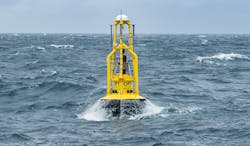The industry has ramped up efforts to trial and further develop wave energy technologies for offshore oil and gas operations.
Ocean Power Technologies Inc.’s (OPT) PB3 PowerBuoy has garnered operators’ attention. This is a power and communication platform for remote offshore applications such as autonomous vehicle charging, meteorological and ocean data collection, subsea equipment powering, and well monitoring. It supports a suite of end user selectable mission critical payloads while extending their range of operation, lowering their operational costs, and enabling real-time data transfer and decision making.
In August 2019, Premier Oil deployed the PB3 PowerBuoy at its Huntington field in the UK central North Sea. The system is serving as an autonomous intelligent platform to provide communications and remote monitoring services. During the field trial, Premier will investigate the system’s ability to monitor the local environment and alert ships of the field’s safety zone as a potential solution to help with its future decommissioning-related operations.
According to the Oil & Gas Technology Centre (OGTC), which is supporting the system development with the operator, this is the first-of-its-kind deployment in the North Sea involving a moored buoy capturing power from the motion of ocean waves to allow it to provide monitoring capabilities and protect subsea architecture. The buoy is designed to serve as an uninterruptible power supply that constantly recharges itself using wave energy and operates in ocean depths from 20 m (66 ft). This energy is harnessed to power on-board sensors (or even those on the seabed), allowing real-time data transfer and communication with remote facilities. And due to its ability to store energy, it can also operate during periods of calm seas.
The OGTC added the technology could also be paired with different payload configurations to support small field developments or deployed as a charging/communications hub for autonomous underwater vehicle (AUV) applications.
Paul Williams, UK Business Unit Manager at Premier, said: “This is a great opportunity to prove new technology which will enable us to minimize the environmental impact of our decommissioning programs, whilst maintaining flexibility to deliver maximum economic recovery from our fields.
“Assuming success, we will look at the potential to deploy this technology on other assets and for different purposes, both in the UK and further afield.”
In November 2018, Eni deployed the PB3 PowerBuoy in the Adriatic Sea off Italy as part of its MaREnergy (marine renewable energy) project. This aims to demonstrate the suitability of wave energy renewable technologies in the oil and gas industry. Six months later the buoy had produced more than one MegaWatt-hour cumulative energy.
The buoy was selected by Eni’s integrated subsea technology systems team to develop applications for remotely controlled field operations powered by wave energy, including environmental monitoring and offshore asset inspection with AUVs.
OPT said the system demonstrated AUV charging capabilities during the trials with Eni, successfully sending power and communications to a subsea payload throughout the test period. The PowerBuoy is being tested as a standalone charging station and communications platform to enable the long-term remote operation of AUVs.
Earlier this year, Eni activated the Inertial Sea Wave Energy Converter production unit at a site offshore Ravenna, eastern Italy. The system is designed to convert energy generated by waves into electricity and is adapted to operate in a variety of sea conditions to ensure high continuity of energy production.
Eni’s Central Northern District installed the pilot plant and integrated it into what the company claims is the world’s sole hybrid smart grid system providing photovoltaics and energy storage. It delivered a maximum power output of more than 51 kW, or 103% of its nominal power.
According to Eni, the technology would be suitable for powering medium and large offshore facilities. The company plans to use this solution to convert its older offshore platforms into renewable energy generation hubs.
Saipem and Finnish company Wello Oy have signed a memorandum of understanding to enhance the latter’s Penguin wave energy converter technology. This is designed to allow a floating hull to transform the motion of ocean waves into energy through a rotator directly connected to a generator.
Saipem will apply its experience in harsh environment offshore projects and in naval engineering to optimize the installation procedure and operability of the technology. In addition, it will investigate applications to the oil and gas industry, including offshore platforms, to improve their energy efficiency and reduce their environmental impact.
Mocean Energy, an Edinburgh-based start-up company, is seeking partners to further development of its Seabase technology, which uses energy from ocean waves to power subsea equipment. The company has attracted funds of £200,000 ($249,000) from Scottish Enterprise and the OGTC in Aberdeen for the development.
Mocean Energy managing director Cameron McNatt described Seabase as “a wave energy machine small enough to fit in a shipping container yet robust enough to generate power in the harsh environment of the North Sea.
“Initially we see it being used to provide backup power to subsea equipment where, for example, an umbilical fails. Longer term, Seabase will provide green power to future generations of field-resident ROVs and autonomous underwater vehicles, reducing vessel costs and emissions.”
In September, the company completed a 10-day testing program at Centrale Nantes in France. Supported through the EU’s MARINET program, Mocean tested a 10th-scale model of Seabase in the university’s main ocean tank.
According to technical director Chris Retzler: “It has given us the opportunity to test Seabase in regular waves and to characterize the model response and to validate numerical models. Further tests in irregular waves will provide data to calculate the output power in real sea conditions, whilst tests in the largest waves will indicate the survival capability of the machine.”
Larger-scale prototype testing at sea is planned by 2022. •






